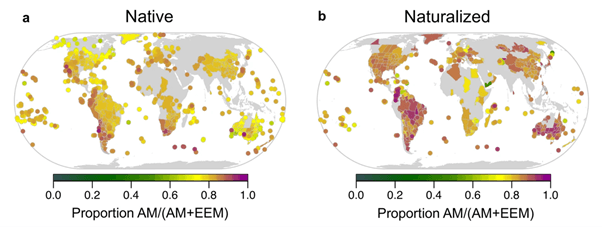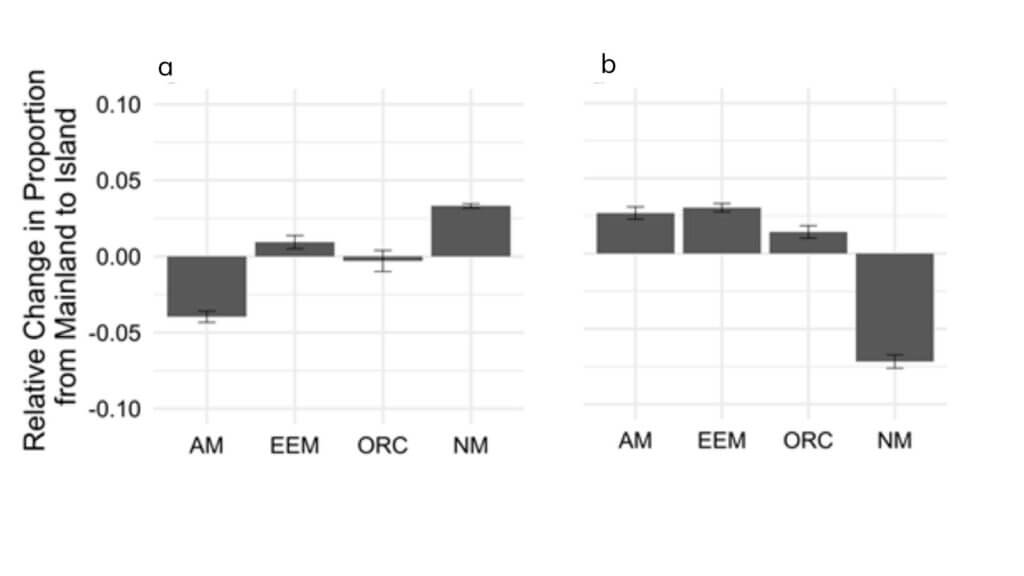Why this matters: Research suggest islands require specific restoration strategies
Dr. Camille Delavaux
If you take a moment to picture a plant – a tree, a flower, a shrub – you’re probably visualising leaves or petals or branches. But there’s also a root system belowground that we typically don’t see and might not even think of. And what can be even harder to see are the underground microscopic fungi that form symbiotic relationships with many plant roots.
One of these groups of fungi are the mycorrhizal fungi (myco = fungi, rhiza = root) which are typically beneficial to the plants they’re in a relationship with. Our research has found that mycorrhizal fungi influence the biogeography of plants – which plants grow where. We were especially curious about what this plant-fungal symbiosis looks like on islands, since island ecosystems can behave quite differently from the mainland. Because plant-mycorrhizal relationships have been studied so much more extensively on mainlands, we wanted to reach a deeper understanding of if and how plant communities on islands are different.
Previously, we found that islands have fewer mycorrhizal plant species than mainlands. This is likely because mycorrhizal fungi have a harder time traveling from the mainland to an island than plants themselves do (seeds can be dispersed by birds or by wind, for instance). The lack of available fungi on mainlands then limits the establishment of plant species that depend on them, the mycorrhizal plant species.
Our recent paper takes this a step further and explores differences between the major types of mycorrhizal fungi and their partnerships with island plants. We wanted to understand this in greater detail, because the specific type of fungi that’s present in the soil affects what plants are native there, which has implications for conservation and restoration work.

Figure 1 | Maps of geographical regions represented in our study, showing the proportion mycorrhizal plant species for native and naturalized floras (a mainland n = 515, island n = 313; b mainland n = 287, island n = 100).
For this research, we analyzed data from more than 300 oceanic islands and compared them to more than 500 mainland sites worldwide, shown in Figure 1. We looked at several types of mycorrhizal fungi: arbuscular mycorrhiza (AM, for short), ectomycorrhizal and ericoid mycorrhiza (EEM), plus orchid mycorrhiza (ORC). We hypothesized that the different ways these two types disperse will influence what type of fungi and related plants are present – or not – on islands. On the one hand, EEM fungi have a structure built for dispersal: they release spores into the air, which can be carried by wind or even animals.
On the other hand, AM fungi haven’t evolved a structure to disperse spores through the air, which makes it harder for them to travel over long distances. In addition, AM fungi can’t grow without their host plant, unlike EEM fungi. As a result, we expected poor establishment of plants associated with poor dispersing fungi. And that’s what we found: AM plants are indeed underrepresented on islands, likely because AM fungi don’t disperse as well.

Figure 2| Plant species that associate with dispersal-limited fungi (AM; blue circles) are underrepresented on islands.
We also looked at how human activity is changing these patterns on islands. Humans are introducing more mycorrhizal plant species (both AM and EEM), likely through ornamental, agricultural, and other means. When plants arrive with their roots in soil (in pots, for example), fungi are along for the ride, too. As a result, the proportion of mycorrhizal plant species on islands is increasing.

So what do these findings tell us? We now see that the incredibly important partnership between plants and fungi that occurs across the Earth is completely different than initially assumed on an entire subset of the world: islands. The plants that arrive and establish on islands are changed by the initial absence of this symbiosis, with the symbiosis representing a lower (although still present) part of the system.
Because most ecological research studies mainlands, the general understanding is that these fungi are essential to most plants in the world, and that they are basically always helpful: introducing AM fungi in severely degraded soils and reintroducing AM fungi in recovering sites accelerates ecosystem recovery. With our work, we now find that island systems may not rely on these fungi as much as mainlands. This means we may need to reassess the assumption that mycorrhizal fungi is always a positive addition to restoration projects. In fact, the addition of mycorrhizal fungi on islands may, in some cases, actually benefit newly introduced plant species instead of native ones.
As a result, traditional assumptions about ecosystems and restoration may need rethinking when applied to islands. Of course, there is more work needed to be able to suggest specific management tactics for any given island system. In the meantime, our findings offer a new and important piece of the puzzle to move toward better conservation and management decisions.
—
Figures 1 and 3 from Delavaux, C.S., Weigelt, P., Dawson, W. et al. Mycorrhizal types influence island biogeography of plants. Commun Biol 4, 1128 (2021). https://doi.org/10.1038/s42003-021-02649-2, licensed under Creative Commons 4.0 http://creativecommons.org/licenses/by/4.0/.
